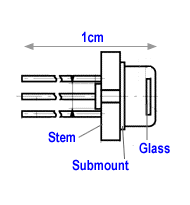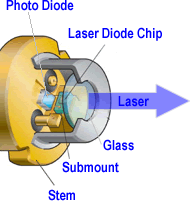By the late 1990s blue lasers were used for making the masters for DVD discs, but this process used hugely expensive special laser-beam recorders the size of a wardrobe and needing a super-clean, vibration-free environment in which to work properly. The challenge for optical drive manufacturers was to enable blue laser technology to be effective in a form that would fit into the space afforded by a PC-ROM drive. However, getting a blue laser to fire out of a small enough diode at one end and not simultaneously punch a hole out of its rear end had stumped the world’s leading technologists for decades.
The objective was clear: to find a blue laser technology that was commercially viable. It had to be small, capable of being mass produced, and be affordable to run for home users – the amount of power the laser needs to produce is a lot for a device hardly bigger than a match-head. Almost from the outset, DVD’s limitations were known, so even while the DVD wars publically raged, scientists frantically sought for its successor in the research labs of industry giants worldwide.
One man, however, working away from the crowd, quietly developed an answer. Shuji Nakamura was pretty much unknown, and worked for what was then a very small time chemical company, the Nichia Corporation. Away from what he regarded as the controlling, stifling influence of conventional corporate wisdom, he used methods and materials that the big gun scientists had shunned. And yet, with comparatively limited funds and resources, Shuji was the one who made the breakthrough.
Shuji built upon work gone before. In the 1960s, RCA’s J.I. Pankove and team worked on creating a gallium nitride (GaN) light emitting diode (LED), aiming principally for a strong white light. They failed to create a marketable solution, but they had made strides. Further work published by Professor Isamu Akaski and team in 1985 was invaluable to Shuji, as they showed their method of creating strongly p-typed GaN – essentially, a form of gallium nitride with the correct properties for creating a bright LED. With this work as a basis, Nakamura honed the science, refined the method, and finally produced the solution: a mass producible GaN LED, which went into production in 1993, and provided the integral basis for blue laser optical disks.


The above images show a blue laser diode, the first a photograph of an actual blue laser diode, magnified about five times. The drawing has external components labelled, and shows scale – clearly these pictures are magnified several times. The following image shows inside the lens casing.

This cutaway shows inside the diode’s casing. Electrical impulse causes light from the photo-diode to be directed through the laser diode chip. Magnified and filtered, the blue laser light is emitted through the glass lens.
- The blue laser diode in optical disk drive technology
- DVD Forum and the Blu-ray Disk Association (BDA)
- Blu-ray vs HD-DVD – the war of the blue laser optical disks
- Blu-ray Region Codes
- Blu-Ray – the Hi-Def Blue Laser Disk Technology
- HD-DVD (High Definition Digital Versatile Disk) – blue laser optical disk
- Blu-ray Disks (BD) – blue laser optical disk technology
- Blu-ray region codes – map and explanation